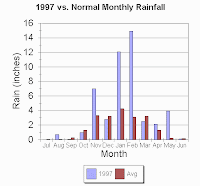 |
| Romeo Pier Peering into the Future |
This blog post is a continuation of my previous post titled El Niño and Buoy 46012 Half Moon Bay
Buoy 46012
I've done some further analysis of the local buoys in an attempt to see if any relationship can be established from the buoy data with respect to the current El Niño predictions. I'm not a climatologist nor do I have a
background in earth climate systems. I'm just a scientifically minded citizen
very concerned about the last 4 drought years and in particular the last 2
historically warm years 2014 and 2015.
I've been tracking the SF buoy in real time along with Bodega Bay, Half Moon Bay and FTPC1 Station at Crissy Field which is a ground reporting station. This is predicted as a significant rain/El Nino event as I will track and compare it to 1997-98 and 1982-83 to see how 2015 compares?
Summary of Buoy Data
Buoys transmit data hourly throughout the year which consist
of wave height and periods, water and air temperatures and barometric pressures
plus additional parameters. The last two El Niño events were 1982-83 and
1997-98. I’m concentrating primarily on 1997-98 because it’s most recent and I
have a good recollection of that year because of the unusual and impressive
rain totals. There are gaps in the buoy data and the most significant gap I
encountered was the Half Moon Bay (HMB) Buoy 46012 which likely due to
technical issues as no water temperature data for the entire year of 1997.
However the San Francisco Buoy (SF) 46026 has more complete water temperature data
up until 11/24/1997. However the water temperature data is absent for the
remainder of 1997 and is absent for 1998 until 2/28/98. So there are 3 months
of contiguous missing water temperature data occurring during the peak El Niño
which is a little discouraging! I may in the future explore the Bodega Bay (Bodega)
Buoy to see if it has more complete data.
In the general bay area waters I rely on 3 buoys, HMB, SF
and Bodega and they generally follow the same temperature progression. January
thru about June water temps average about 13°C and start to warm up reaching a
peak in September of 15°C, then October thru December the temperatures decrease
with the coming of winter back to about 13°C.
What Did 1997 Look Like?
The 1997-1998 rainfall season was one of nearly epic
proportions for San Francisco. Numerous
San Francisco records were set as the influences of an extremely strong El Niño
were felt throughout the State.
 |
| SF Buoy 1997 |

Most notably it was the second wettest rainfall season
(47.22 inches) in the 149 seasons since records began in San Francisco in
1849. The previous second wettest season
was 45.85 inches in 1889-1890. The
seasonal record remains 49.27 inches from 1861-1862; however over 24 inches of
that season's total fell in the month of January 1862. [The average seasonal rainfall (1961-1990) is
20.52 inches.]
Possibly more remarkable were the record 119 days when
measurable rainfall was recorded, shattering the previous mark of 107 from the
1889-1890 season.
 |
Fig.4. Water Temperatures
1982/1997/2008/Present |
Summary
Figure 4 is a comparison of 3 previous years, 1982 and 1997 last El Niño years and 2008 a typical year to the present year 2015. Note the 1997 data ends on November 24, 1997. All curves basically follow the same pattern peaking in the early fall and dropping as the year ends. The 1997 data deviates from that pattern showing a higher temperature of about 5 degrees F and not fading as other years do. As mentioned before the data is limited and has missing information for 1997. It's interesting to note that in November of 1997 San Francisco had almost 7 inches of rain, while there was 1,43 inches of rain this past November. It's intriguing to wonder if the 5 degree warmer water in 1997 accounts for the higher November rain totals? To pursue this further I will next look at the 1997 Bodega Bay data to see if there is more complete water temperature data!
Update 12/3/15 checking Bodega buoy data finds no useable data for all of 1997 and no data in 1998 until 3/28/98. So no earth shaking revelations here, just an exercise by a concerned citizen to help shake out the speculations from the actual data. Although our local waters are just a small part of the whole system, I wonder if water temperatures locally can be predictors of the El Niño effect.....not sure of that but the elevated temperatures over 2014 and 2015 is surly indications of a planet in distress!
















